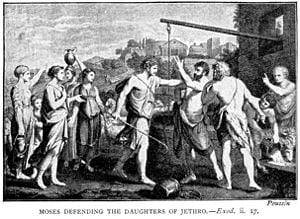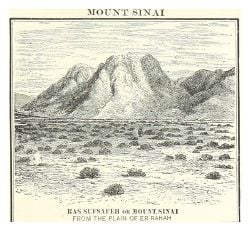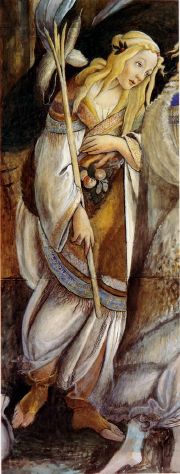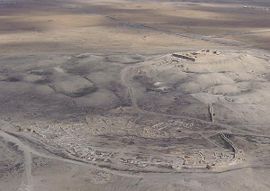
The Kenites were a nomadic tribe of the ancient Levant, many of whom became affiliated with the Israelites. The Kenites are described as showing kindness to the Israelites during the Exodus and later settling among them in the tribal areas of Judah and Naphtali after the conquest of Canaan. They intermarried with the Israelites and are depicted in the biblical narratives as supporting Israel in its fight against the Canaanites and Amalekites.
Among the well-known Kenites were Jethro, the "priest of Midian," and his daughter Zipporah, who became the wife of Moses and mother of his two sons. The biblical heroine Jael, who slew the Canaanite general Sisera after the battle of Mount Tabor, was the wife of Heber the Kenite.
Modern scholars believe the Kenites were shepherds and metalworkers, who may have shared some of their vital technological knowledge with the Israelites. For the most part, they seem to have assimilated into the Israelite population, although the Rechabites, a Kenite clan, maintained a distinct nomadic lifestyle until at least the time of Jeremiah.
According to one theory, the Hebrew God Yahweh was originally a tribal god of the Kenites and was later identified by the Israelites with the God of Abraham, whom he knew as "El Shaddai."
Name
The Kenites first appear in the Bible in the time of Abraham as occupying part of the land of Canaan (Genesis 15:19). The name "Kenite" or "Kainite" derives from the Hebrew Qayin, which is identical with the name "Cain." However, the tribe's actual origins are obscure. Its name may also be derived from the name of Kenan, the son of Enos (and thus the grandson of Seth and great-grandson of Adam). Another possibility is that the Kenites may be related to the "Kennizites" or to Kenaz the brother of Caleb, since Caleb is described in the Book of Chronicles as being an ancestor of certain Kenite clans.
In the Bible

At the time of the Exodus, at least some of the Kenites are depicted as inhabiting the vicinity of Mount Sinai. Jethro, the father-in-law of Moses, was a Kenite (Judges 1:16), and Moses is described as living with his clan for 40 years, where he married Jethro's daughter Zipporah. Elsewhere, Jethro is said to have been the "priest of Midian" (Exodus 3:1) and himself a Midianite (Numbers 10:29). This has led some scholars to believe that the terms "Kenite" and "Midianite" are intended to be used interchangeably. Others hold that the Kenites were one nomadic tribe that originally lived in Canaan, some of whom moved to the land of Midian, along with other groups such as the Amalekites.
The Kenites of Sinai apparently traveled with the Israelites back toward Canaan. Their encampment, however, was separate from the main body of the Israelites, and was noticed as such by the prophet Balaam as the Israelites approached the land of Canaan and camped along the Jordan River across from Jericho (Numbers 24:21-22). Baalam prophesied that "you Kenites will be destroyed when Asshur takes you captive," possibly referring to their shared fate with the northern kingdom of Israel, which was defeated by Assyria in 722 B.C.E.
At the beginning of the period of the judges, some of the Kenites traveled from Jericho (the "City of Palms") and went with the tribe of Judah to live in the Judean desert near Arad (Judges 1:16), southwest of the Dead Sea. Another clan later separated from this group and settled near Kadesh in the land of Naphtali, near the border of modern Lebanon. There, the Canaanite general Sisera fled to the tent of Heber the Kenite after being routed at the battle of Mount Tabor, where he was famously slain by Heber's wife Jael. She is memorialized as one of Israel's greatest heroines in the Song of Deborah:
- Most blessed of women be Jael, the wife of Heber the Kenite,
- most blessed of tent-dwelling women.
- He (Sisera) asked for water, and she gave him milk;
- In a bowl fit for nobles she brought him curdled milk.
- Her hand reached for the tent peg, her right hand for the workman's hammer.
- She struck Sisera, she crushed his head, she shattered and pierced his temple. (Judges 5:24-26)
By the time of Saul, the Kenites are described as having settled in towns of Judah. However, some of them also lived in tents among the Amalekites, and Edomite clan that, like the Kenites, had camped near the Israelites near the Jordan but had incurred their enmity for attacking them during the Exodus. Before destroying the Amalekites at God's command, Saul warned the Kenites of his plans, giving them the opportunity to separate themselves from the Amalekites before the attack began. "You showed kindness to all the children of Israel, when they came up out of Egypt," said Saul to them (1 Samuel 15:6). Later, after David had defeated a group of Amalekites and gained much booty in the process, he included leaders of the Kenite towns among "the elders of Judah, who were his friends," with whom he shared the loot (1 Samuel 30:28-29).
The Book of Chronicles indicates a lineal connection between the Kenites and Caleb, through his wife Ephrath, their son Hur, and their grandson Salma, stating:
The descendants of Salma: Bethlehem, the Netophathites, Atroth Beth Joab, half the Manahathites, the Zorites, and the clans of scribes who lived at Jabez: The Tirathites, Shimeathites and Sucathites. These are the Kenites who came from Hammath, the father of the house of Rechab (1 Chronicles 2:50-55).
The Rechabites
The Rechabites (also spelled Recabites), identified above as derived from the Kenites, remained a nomadic group ascetically committed to the desert traditions of their ancestors and fiercely devoted to Yahweh. The Rechabite leader Jehonadab was instrumental in supporting the usurper Jehu of Israel, helping him to carry out the massacre of the family of Ahab and the priests of Baal in the city of Samaria (2 Kings 10:15-27).
The Rechabites finally came to live at Jerusalem as a result of the invasion of Nebuchadnzezzar II in the early sixth century CE and were given shelter by the prophet Jeremiah. When the prophet offered them hospitality in the Temple of Jerusalem, he learned of their tradition and reported it as follows:
We do not drink wine, because our forefather Jonadab son of Rechab gave us this command: "Neither you nor your descendants must ever drink wine. Also you must never build houses, sow seed or plant vineyards; you must never have any of these things, but must always live in tents. Then you will live a long time in the land where you are nomads." ...We have lived in tents and have fully obeyed everything our forefather Jonadab commanded us (Jer. 35:6-10).
Critical view
The fact that Jethro was both a "priest of Midian" and a Kenite indicates that the Kenites were probably one of the Midianite tribes. Jethro is also depicted as a priest of Yahweh/Elohim:
"Praise be to the Lord, who rescued you from the hand of the Egyptians and of Pharaoh, and who rescued the people from the hand of the EgyptiansâŚ" Then Jethro, Moses' father-in-law, brought a burnt offering and other sacrifices to God (Elohim), and Aaron came with all the elders of Israel to eat bread with Moses' father-in-law in the presence of God (Exodus 18:10-12).
Not long before this, the Bible says the Hebrew God El Shaddai revealed his identity with Yahweh, saying to Moses: "I appeared to Abraham, to Isaac and to Jacob as God Almighty (El Shaddai), but by my name the Lord (Yahweh) I did not make myself known to them" (Exodus 6:3).

Some suggest that the sacramental meal Jethro shared with Aaron describes an initiation of Aaron, the future high priest of Israel, into the worship of Yahweh, and that Moses, too, had first been introduced to this deity by his father-in-law during Moses' stay with Jethro's family near Mount Sinai. In this view, Yahweh was originally a Kenite deity, and his worship passed to the Israelites from Jethro through Moses and Aaron.
The Bible also describes Jethro assisting Moses in the organization of a court system (Exodus 18:24-26), suggesting that some aspects of ancient Israelite jurisprudence may have derived from Kenite sources.
Exactly how the Kenites and Israelites became affiliated is a matter of considerable discussion. It seems that by the time of David, the Kenites became fully incorporated into the tribe of Judah. Their eponymous ancestor may have been Cain, and some have speculated that the genealogy of Cain in the Book of Genesis may contain oral Kenite traditions. The writer in Genesis 4 attributes the invention of the art of working bronze and iron working to Cain's descendants, leading scholars to speculate that the Kenites shared these valuable skills with the Israelites, who still did not possess the skill of blacksmithing in the time of King Saul (1 Samuel 13:19).
The Kenites also serve as a primary example of the thesis that the "Israelites" did not truly constitute a group of lineal descendants of Jacob, but a federation of clans and tribes which later came to adopt a common origin myth into which various groups were amalgamated as the "sons of Jacob." According to this thesis, some of the "Israelites"âperhaps including the Kenitesânever actually made the Exodus from Egypt, but joined the Israelite federation from the time of the judges through the time of David and Solomon and beyond.
ReferencesISBN links support NWE through referral fees
- Charlesworth, James H. The History of the Rechabites. Chico, CA: Scholars Press, 1982. ISBN 978-0891305675.
- Dever, William G. Who Were the Early Israelites, and Where Did They Come from? Grand Rapids, MI: William B. Eerdmans Pub. Co, 2003. ISBN 978-0802809759.
- Weippert, Manfred. The Settlement of the Israelite Tribes in Palestine; A Critical Survey of Recent Scholarly Debate. Studies in Biblical theology, 2d ser., 21. Naperville, Ill: A.R. Allenson, 1971. OCLC 163460
- Wilson, Ian. Exodus: The True Story Behind the Biblical Account. San Francisco: Harper & Row, 1985. ISBN 978-0062509697.
- This article incorporates text from the 1901â1906 Jewish Encyclopedia, a publication now in the public domain.
External links
All links retrieved March 2, 2025.
- Kenites Jewish Encyclopedia.
Credits
New World Encyclopedia writers and editors rewrote and completed the Wikipedia article in accordance with New World Encyclopedia standards. This article abides by terms of the Creative Commons CC-by-sa 3.0 License (CC-by-sa), which may be used and disseminated with proper attribution. Credit is due under the terms of this license that can reference both the New World Encyclopedia contributors and the selfless volunteer contributors of the Wikimedia Foundation. To cite this article click here for a list of acceptable citing formats.The history of earlier contributions by wikipedians is accessible to researchers here:
The history of this article since it was imported to New World Encyclopedia:
Note: Some restrictions may apply to use of individual images which are separately licensed.


